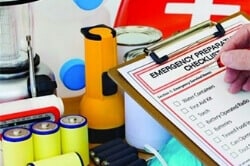
California has its earthquakes. Kansas has its “twisters.” New England has its nor’easters. And along other areas, the southeast has its hurricanes. Hurricane season, the time of the year when more hurricanes hit, is June 1 through Nov. 30. It’s during this time that hurricane preparedness becomes important.
How do you prepare for a hurricane? First, know your hurricane facts and understand common terms used during hurricane forecasts. Storm conditions can vary on the intensity, size and even the angle which the tropical cyclone approaches your area, so it is vital you understand what the forecasters and news reporters are telling you.
Before a storm is categorized as a hurricane, there are two other categories it must progress through. Tropical depressions are cyclones with winds of 38 mph. Tropical storms vary in wind speeds of 39–73 mph. Hurricanes have winds blowing at 74 mph and greater. Typically the upper right quadrant of the storm (the center wrapping around the eye) is the most intense portion of the storm.
Here are some important terms you may hear in conjunction with large storms and what they mean:
Watch: A tropical storm or hurricane watch means the conditions for a tropical storm or hurricane, respectively, are possible in the area. Watches are issued 48 hours in advance of the anticipated onset of the storm’s winds.
Warning: A tropical storm or hurricane warning means the conditions are expected in the area. Warnings are issued 36 hours in advance of the anticipated onsite of the storm’s winds.
Eye: The clear, sometimes well-defined center of the storm with calmer conditions. The eye is surrounded by the eye wall, which contains some of the most severe weather of the storm with the highest wind speed and largest precipitation.
Rain Bands: Bands coming off the cyclone can produce severe weather conditions such as heavy rain, wind and tornadoes.
Storm Surge: An often underestimated and deadly result of ocean water swelling as a result of a landfalling storm, quickly flooding coastal areas and sometimes areas further inland.
During a watch, prepare your home and an evacuation plan in case a warning is issued. During a warning, carefully follow the directions of officials, and immediately leave the area if they advise it. In the event of an extreme wind warning/advisory, which means that extreme sustained winds of 115 mph or greater are expected to begin within an hour, immediately take shelter in the interior portion of a well-built structure.
Hurricane Kits
It is important to create a kit of supplies that you could take with you if you are forced to evacuate. This kit will also be useful if you are able to stay in your home, but are still affected by the storm, such as through the loss of power. One common trend seen when hurricanes are approaching is a wide-spread panic. When this happens, people rush in large numbers to get all the supplies they think they need. However, if you prepare your kit ahead of time, you can alleviate a lot of the potential stress of a very chaotic situation. You should create your kit in a bag that you can easily take with you. Some recommended items to include are:
Securing Your Home
Know how to secure your home in the event of damaging winds, storm surge and flooding.
Remember, any severe storm can be deadly and destructive. If you’ve been in the path of a hurricane, you know the inconvenience and distress it can cause. One of the best tips to being prepared is knowing the cycle of a hurricane: approach, arrival and aftermath. Prepare ahead of time and listen to the directions of officials for the approach, secure your home or find a safe shelter for its arrival, and know how to proceed safely during the aftermath.
Source: www.stateofflorida.com